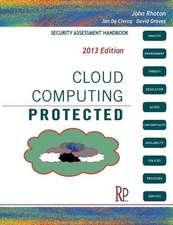Microsoft Windows Security Fundamentals: For Windows 2003 SP1 and R2
Autor Jan de Clercq, Guido Grillenmeieren Limba Engleză Paperback – 12 noi 2006
Since its release in 2003 the Microsoft Exchange server has had two important updates, SP1 and SP2. SP1, allows users to increase their security, reliability and simplify the administration of the program. Within SP1, Microsoft has implemented R2 which improves identity and access management across security-related boundaries. R2 also improves branch office server management and increases the efficiency of storage setup and management. The second update, SP2 minimizes spam, pop-ups and unwanted downloads. These two updated have added an enormous amount of programming security to the server software.
* Covers all SP1 and SP2 updates
* Details strategies for patch management
* Provides key techniques to maintain security application upgrades and updates
Preț: 670.72 lei
Preț vechi: 838.40 lei
-20% Nou
Puncte Express: 1006
Preț estimativ în valută:
128.34€ • 134.01$ • 105.98£
128.34€ • 134.01$ • 105.98£
Carte tipărită la comandă
Livrare economică 15-29 aprilie
Preluare comenzi: 021 569.72.76
Specificații
ISBN-13: 9781555583408
ISBN-10: 1555583407
Pagini: 832
Dimensiuni: 191 x 235 x 33 mm
Greutate: 1.29 kg
Editura: ELSEVIER SCIENCE
ISBN-10: 1555583407
Pagini: 832
Dimensiuni: 191 x 235 x 33 mm
Greutate: 1.29 kg
Editura: ELSEVIER SCIENCE
Public țintă
• IT Specialists and Solution Architects involved in the planning and design of a Windows Server 2003 infrastructure.• Windows consultants that want to understand at a deep level how security in Windows Server 2003 works.
• Security Consultants that want to get a clear view on Microsoft OS security.
• IT Managers that want to develop a vision around the security of their Windows Server 2003 infrastructure.
Cuprins
Foreword
Preface
Chapter 1: The Challenge of Trusted Security Infrastructures
Chapter 2: Windows Security Authorities and Principals
Chapter 3: Trust Relationships
2 Authentication
Chapter 4: Introducing Windows Authentication
Chapter 5: Kerberos
Chapter 6: IIS Authentication
Chapter 7: Unix Authentication Integration
Chapter 8: Single Sign-on
Chapter 9: Introducing Windows Authorization
Chapter 10: Active Directory Authorization
Chapter 11: Active Directory Delegation
Chapter 12: Malicious Mobile Code Protection
Chapter 13: Rights Management Services
Chapter 14: Introducing Microsoft Identity Management
Chapter 15: Identity Management Repositories
Chapter 16: AD Federation Services
Chapter 17: Introducing Windows Public Key Infrastructure
Chapter 18: Windows PKI Trust
Chapter 19: The Certificate Lifecycle
Chapter 20: Building a Windows Server 2003 Public Key Infrastructure
Chapter 21: PKI-enabled applications
Chapter 22: Security Policy Management
Chapter 23: Security Patch Management
Chapter 24: Security-related Auditing
Chapter 25: Active Directory Disaster Recovery
Preface
Chapter 1: The Challenge of Trusted Security Infrastructures
Chapter 2: Windows Security Authorities and Principals
Chapter 3: Trust Relationships
2 Authentication
Chapter 4: Introducing Windows Authentication
Chapter 5: Kerberos
Chapter 6: IIS Authentication
Chapter 7: Unix Authentication Integration
Chapter 8: Single Sign-on
Chapter 9: Introducing Windows Authorization
Chapter 10: Active Directory Authorization
Chapter 11: Active Directory Delegation
Chapter 12: Malicious Mobile Code Protection
Chapter 13: Rights Management Services
Chapter 14: Introducing Microsoft Identity Management
Chapter 15: Identity Management Repositories
Chapter 16: AD Federation Services
Chapter 17: Introducing Windows Public Key Infrastructure
Chapter 18: Windows PKI Trust
Chapter 19: The Certificate Lifecycle
Chapter 20: Building a Windows Server 2003 Public Key Infrastructure
Chapter 21: PKI-enabled applications
Chapter 22: Security Policy Management
Chapter 23: Security Patch Management
Chapter 24: Security-related Auditing
Chapter 25: Active Directory Disaster Recovery








